Ijraset Journal For Research in Applied Science and Engineering Technology
- Home / Ijraset
- On This Page
- Abstract
- Introduction
- Conclusion
- Copyright
Optimum Mix Design of GPC using Taguchi method
Authors: Dilip Srinivas, Dr N Suresh
DOI Link: https://doi.org/10.22214/ijraset.2024.58560
Certificate: View Certificate
Abstract
The goal of the current study is to identify geopolymer concrete as an alternative to cement-free concrete. Although there have been numerous attempts to comprehend the necessity of carbon-free concrete, cement-free concrete needs to be replaced. Bagasse ash and GGBS were utilized as the binders in the current study. Various molar concentrations of GPC concrete, including 4M, 8M, and 12M, have been cast, with boric acid being used as an admixture. The objective of the study is to identify the optimal mix design, which has been aided by the well-known Taguchi analysis method. The findings show the ideal mixture of components needed to satisfy the fresh and hardened qualities of GPC at ambient and elevated temperature. Mix design is arranged as per the L18 orthogonal array of Taguchi method. After the completion of casting of concrete specimens, it has been cured for 3days,7days ,28days. At certain days of age, the specimens gain strength. The curing has been done by the sunlight. After that specimens are subjected to elevated temperature of 200C, 400C 600C ,800C up to the duration of 2 hours then cooling the specimens. The residual strength is tabulated.
Introduction
I. INTRODUCTION
The word "geopolymer" was first used by Prof. T. Davidovits to refer to mineral polymers that have an interconnected network of inorganic molecules [16]. Alkaline liquids like NaOH and Na2SiO3 are combined with a silica and alumina-rich source material to create geopolymer[ 17]. The usage of concrete worldwide is the second most significant reason. When making concrete, ordinary Portland cement is frequently utilized as the main binder.
Some authors claim that the polymeric reaction of alkaline liquids with sodium silicate and sodium hydroxide can create additional binder material. It is a new building material that will be produced through chemical reactions between inorganic molecules. It can be manufactured without the need for Portland cement. By reacting aluminate and silicate-bearing minerals with bagasse ash and GGBS, geopolymer concrete is produced. Ash and slag, waste products from the processing of iron and metal, are frequently employed, which helps to maintain a better atmosphere
A. Taguchi Method
Taguchi may be a contemporary approach to experimental design that follows precise rules. An array subset known as orthogonal arrays is used in this method. These reference arrays show how to perform the minimum amount of experiments required to fully understand every element affecting the output parameter. The optimal geopolymer concrete mix style is ascertained using the Taguchi method.
With a small number of experiments, it will offer comprehensive information regarding the intensity of the variation parameter of the geopolymer concrete.
The process of choosing the most comprehensive combinations of the input design variables for an experiment is guided by the orthogonal arrays approach. A common table is utilized to arrange the control factors in this orthogonal series. Using a robust design of trials to lower variation during a phase is the Taguchi method's approach. This method minimizes the experiment's cost by lowering the number of tests. Japan's Dr. Genichi Taguchi created this method. The Taguchi approach facilitates the creation of experiments and the study of how different parameters and control factors affect the mix design., Olivia Monita et al. This study compares the effects of fly ash-based GPC and OPC on the mechanical properties and durability of concrete using the Taguchi method. This instance considers L9 OA. Aggregate content, the ratio of alkaline solution to fly ash, the ratio of sodium silicate to sodium hydroxide, and the curing technique are the experiment's parameters. It was determined that compared to OPC, fly ash GPC had a higher modulus of elasticity, drying shrinkage, water absorption, and sorptivity, as well as higher compressive, tensile, and flexural strengths.
GPC concrete had a flexural strength that was 1.4 times greater than OPC concrete, The findings showed that adding ferro sand aggregate to concrete enhances its strength whereas adding fly ash decreased it. Erdogan Ozbay This study uses the Taguchi technique to investigate the mix proportional parameter of high strength self-compacting concrete; the L18 orthogonal array is used in this instance. however GPC concrete was more prone to corrosion. Ali Nazari and Shadi Riahi etal, studied the Taguchi method to examine the compressive strength of GPC through testing in an oven and with water. Water use for two and seven days is adopted. Oven curing required three different temperatures—25, 70, and 90 degrees Celsius—as well as three different times and concentrations of NaoH molarity. ANOVA software is used to analyse the outcome and identify the optimal amount. The outcome demonstrates that a seven-day water curing period has a high compressive strength
More compressive strength is obtained via oven curing at 90 degrees Celsius than from water curing. Specimens with higher temperatures showed the highest strength growth. Khairun Azizi Azizli and Ahmer Ali Siyal ,This work uses the Taguchi method to study GPC setup times. Additionally, the effect of temperature, water to solid (W/S) ratio, parameter ratio (Si/Al), and Na/Al ratio on fly ash setting is determined in this research. The setting time is ascertained using the GPC vicat needle device. Two sets of temperature and ratio are taken into consideration for comparison. Thus, the outcome demonstrates that the W/S ratio has a good setting. Pathil Prashant V. et al. Using a L9 orthogonal array, the paper assesses the mechanical and physical characteristics of concrete that contains fly ash and ferro sand. Fly ash (10%,20%, and 30%) and fine aggregate (15%, 30%, and 50%) are the parameters. The split tensile, compressive, and flexural strengths of these specimens were measured. The W/C ratio, fly ash content, air entraining agent (AE) content, super plasticizer content, and fine aggregate to total aggregate (s/a) were the six parameters. The mechanical strength of these specimens was examined; the best mix design is employed to measure the mechanical strength.
II. EXPERIMENTAL DETAILS
A. Constituents of Materials
The properties of the following materials are listed below:
- GGBS (Ground Granulated Blast Furnace Slag): It's made by cooling molten iron slag. It is a byproduct of the iron and steel industry. It is nonmetallic product which act as a good resistance to chloride attack in concrete. GGBS contains calcium silicates that forms in a liquid condition with steel or iron in a blast furnace. The incremental hydration of GGBS cement produces less peak and total heat than OPC.
- Bagasse ash: The burning of sugar cane from the sugar cane industries the residue obtained is called sugar cane bagasse as. Generally, this material is rich in silica content and in some cases used to fill the land fill as a disposal material. Replacement of 30% of bagasse ash is used as binder content in concrete for structural purpose.
- Sodium hydroxide: It is the in- organic chemical which is also known as lye and caustic soda. It consists of alumino silicates which leads to increase of hydroxide concentration. Increase in sodium hydroxide concentration gives higher compressive strength in GPC.
- Sodium silicate: It is the alkaline solution, which is white soluble solids when it is placed in water to form alkaline solution. It is glass, color less and soluble in water.
- Manufactures sand (fine aggregate): It is the artificial sand which is produced from crushing hard stones to small powdered particles, it is finely graded which can be used as construction aggregate. It shows superiority to river sand for the construction.
Bulk density of fine aggregate (M sand)
- The density of loose sand = 1528.3 kg/m3
- The density of compacted sand = 1691.82 kg/m3
6. Coarse aggregate: It is made from the rock quarries from the ground deposits which are used for the construction components. These includes crushed stone which are used for the concrete. The coarse aggregate which is used in GPC is 20mm nominal size.
7. Boric acid: Boric acid used in concrete to get the workability of the concrete.
B. Specific gravity of the material Table 2.1

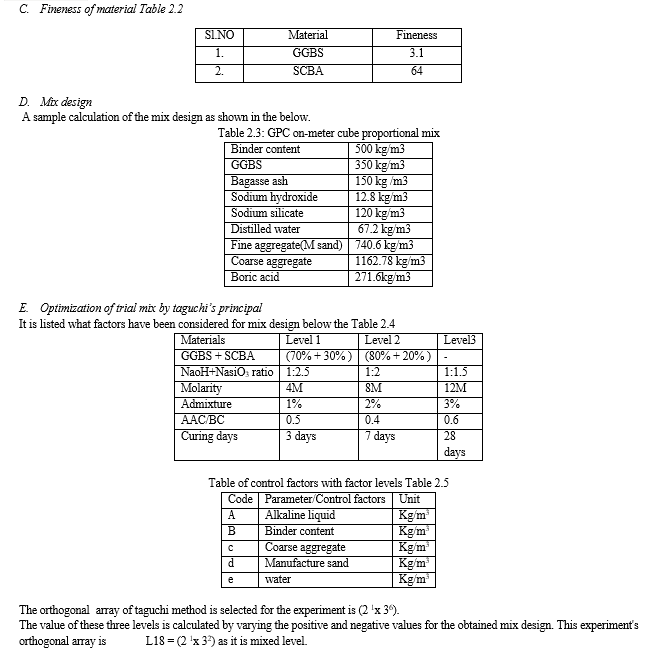
III. RESULTS AND DISCUSSION
Identifying the optimal mix's power characteristics. Cubes were used to cast the GPC of 150 * 150 mm. Slump test was done for each experiment mix.
Geopolymer specimens are tested after the 28 days of casting, these specimens are tested for both ambient and elevated temperature of the casted specimens. All these specimens are tested to find the compressive strength of the geopolymer concrete and also to find the slump of the concrete.
A. Slump Test
As the attempts has been done by using the different percentage of boric acid like 1% ,2%,3% in the trail mix. It has been observed that as the percentage of the boric acid increases for the trail mixes the workability has been decreased. The optimum percentage of boric acid can be restricted to 1% only. The slump results of the attempted trail mixes has shown in the below table with the graphical representation.
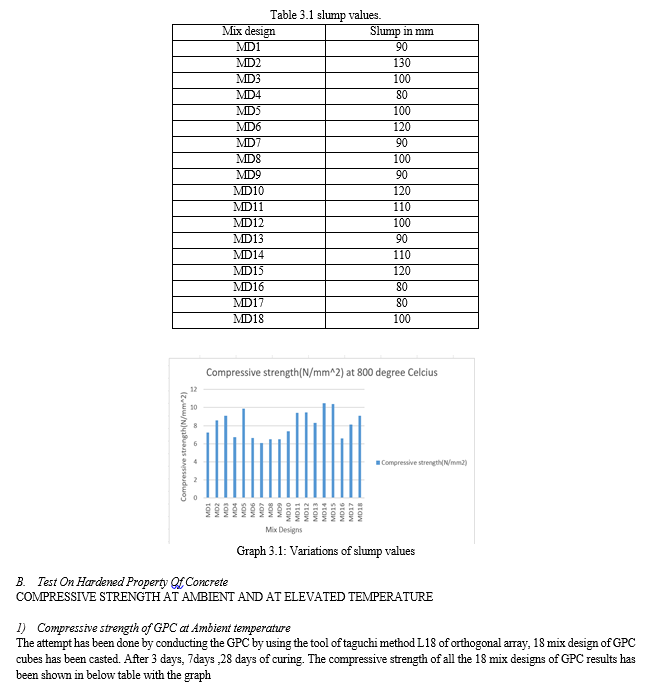


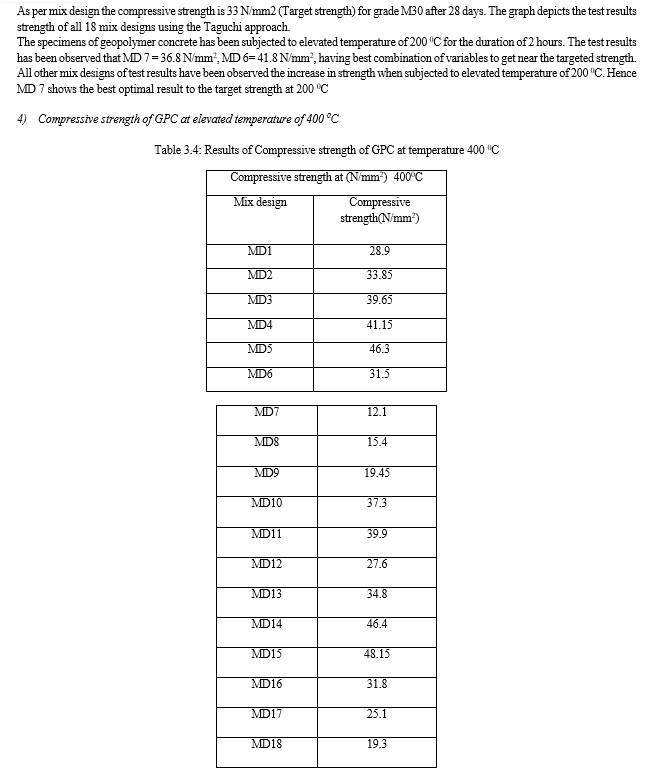
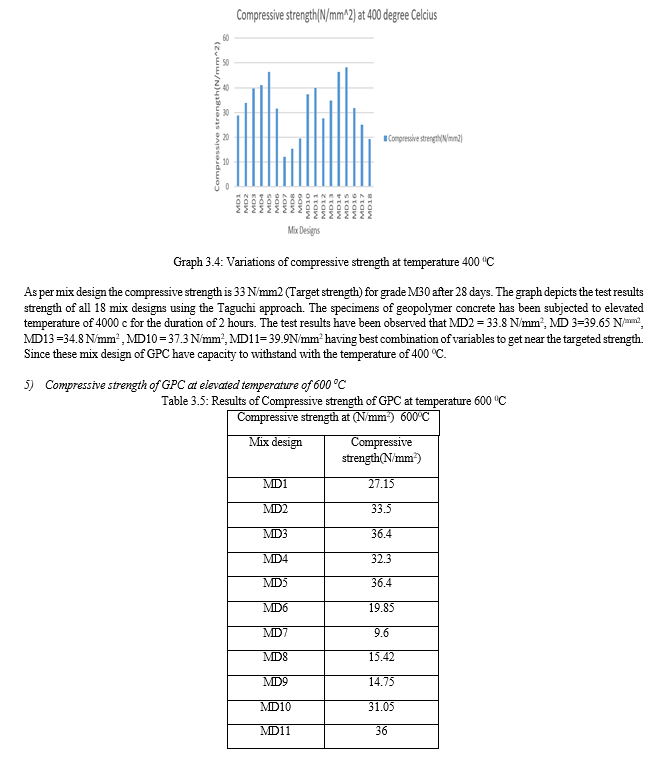

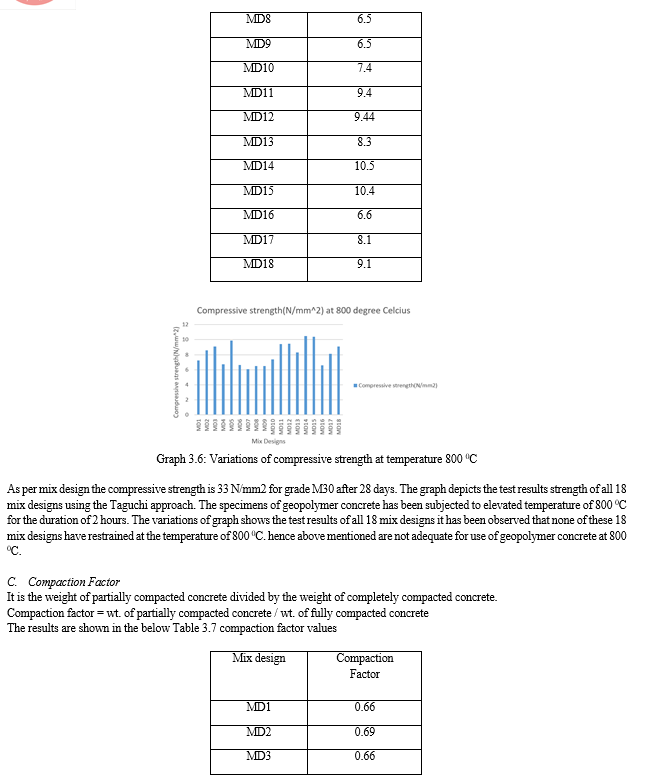

- Fineness of material Table 2.2
|
Sl.NO |
Material |
Fineness |
|
1. |
GGBS |
3.1 |
|
2. |
SCBA |
64 |
- Mix design
A sample calculation of the mix design as shown in the below.
Table 2.3: GPC on-meter cube proportional mix
|
Binder content |
500 kg/m3 |
|
GGBS |
350 kg/m3 |
|
Bagasse ash |
150 kg /m3 |
|
Sodium hydroxide |
12.8 kg/m3 |
|
Sodium silicate |
120 kg/m3 |
|
Distilled water |
67.2 kg/m3 |
|
Fine aggregate(M sand) |
740.6 kg/m3 |
|
Coarse aggregate |
1162.78 kg/m3 |
|
Boric acid |
271.6kg/m3 |
- Optimization of trial mix by taguchi’s principal
It is listed what factors have been considered for mix design below the Table 2.4
|
Materials |
Level 1 |
Level 2 |
Level3 |
|
GGBS + SCBA |
(70% + 30% ) |
(80% + 20% ) |
- |
|
NaoH+NasiO3 ratio |
1:2.5 |
1:2 |
1:1.5 |
|
Molarity |
4M |
8M |
12M |
|
Admixture |
1% |
2% |
3% |
|
AAC/BC |
0.5 |
0.4 |
0.6 |
|
Curing days |
3 days |
7 days |
28 days |
Table of control factors with factor levels Table 2.5
|
Code |
Parameter/Control factors |
Unit |
|
A |
Alkaline liquid |
Kg/m3 |
|
B |
Binder content |
Kg/m3 |
|
c |
Coarse aggregate |
Kg/m3 |
|
d |
Manufacture sand |
Kg/m3 |
|
e |
water |
Kg/m3 |
The orthogonal array of taguchi method is selected for the experiment is (2 1x 36).
The value of these three levels is calculated by varying the positive and negative values for the obtained mix design. This experiment's orthogonal array is L18 = (2 1x 32) as it is mixed level.
- RESULTS AND DISCUSSION
Identifying the optimal mix's power characteristics. Cubes were used to cast the GPC of 150 * 150 mm. Slump test was done for each experiment mix.
Geopolymer specimens are tested after the 28 days of casting, these specimens are tested for both ambient and elevated temperature of the casted specimens. All these specimens are tested to find the compressive strength of the geopolymer concrete and also to find the slump of the concrete.
- Slump Test
As the attempts has been done by using the different percentage of boric acid like 1% ,2%,3% in the trail mix. It has been observed that as the percentage of the boric acid increases for the trail mixes the workability has been decreased. The optimum percentage of boric acid can be restricted to 1% only. The slump results of the attempted trail mixes has shown in the below table with the graphical representation.
Conclusion
A GGBS and Bagasse ash based geopolymer was optimized by using a dynamic approach of the Taguchi method. The output results of slump, compaction factor, compresssive strength of the geopolymer concrete is shown by the graphical representation under optimized conditions were obtained. It was confirmed that the geopolymer manufactured with the optimized conditions exhibits good compressive strength at ambient temperature. As the compressive strength is reduced when it is exposed to elevated temperature. Geopolymer concrete shows the good workability with long term strength. From on the experimental observation, the following conclusion are made. 1) GPC has been achieved by the mixes which are designed by Taguchi method. 2) Among the 7 control factors AAC/BC and the ratio of NaOH+NaSiO3 and molarity of NaOH having significant effects on the strength of the GPC. 3) Boric acid has no significant effect on the strength of GPC. 4) Taguchi analysis indicated that the optimum parameters for compressive strength of concrete at ambient temperature were obtained from MD 734.6 N/mm2, MD 6= 39.5 N/mm2, MD 1=40.79 N/mm2, and MD 8 =40.84 N/mm2 which were close to the target strength. 5) In the present investigation it shows that MD6, MD7 has adequate strength for use of geopolymer concrete at 2000c. 6) In the present investigation it shows that MD2, MD3, MD13, MD10, MD11 has adequate strength for use of geopolymer concrete at 4000c. 7) In the present investigation it shows that, MD3, MD 5 has adequate strength for use of geopolymer concrete at 6000c. 8) Based on present investigation it shows that results of all 18 mix designs it has been observed that none of these 18 mix designs have restrained at the temperature of 8000C. 9) As the percentage of the GGBS increases the strength increases. 10) It has observed as the molarity increases the compressive strength also increases. 11) Spalling, cracks or any other physical changes are not found till the temperature reaches 6000C. 12) The residual strength of GPC at elevated temperature gives less compressive strength.
Copyright
Copyright © 2024 Dilip Srinivas, Dr N Suresh . This is an open access article distributed under the Creative Commons Attribution License, which permits unrestricted use, distribution, and reproduction in any medium, provided the original work is properly cited.

Download Paper
Paper Id : IJRASET58560
Publish Date : 2024-02-22
ISSN : 2321-9653
Publisher Name : IJRASET
DOI Link : Click Here
 Submit Paper Online
Submit Paper Online

